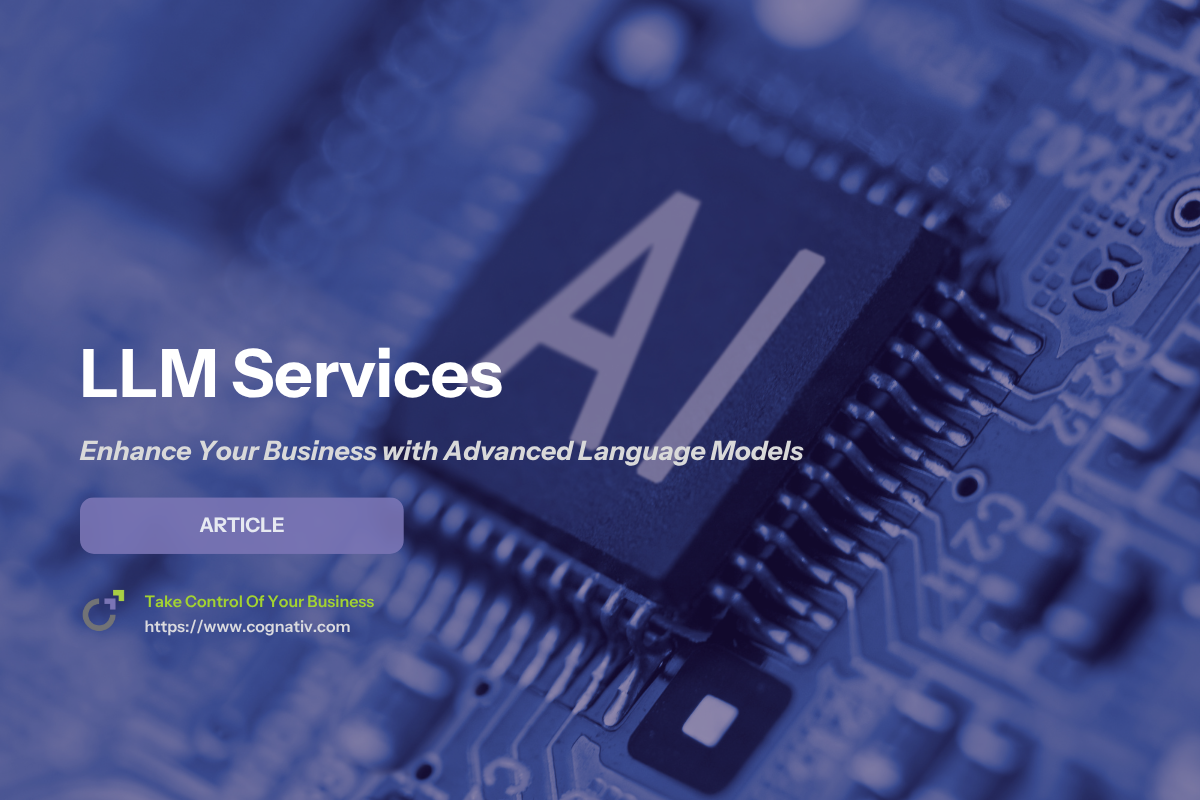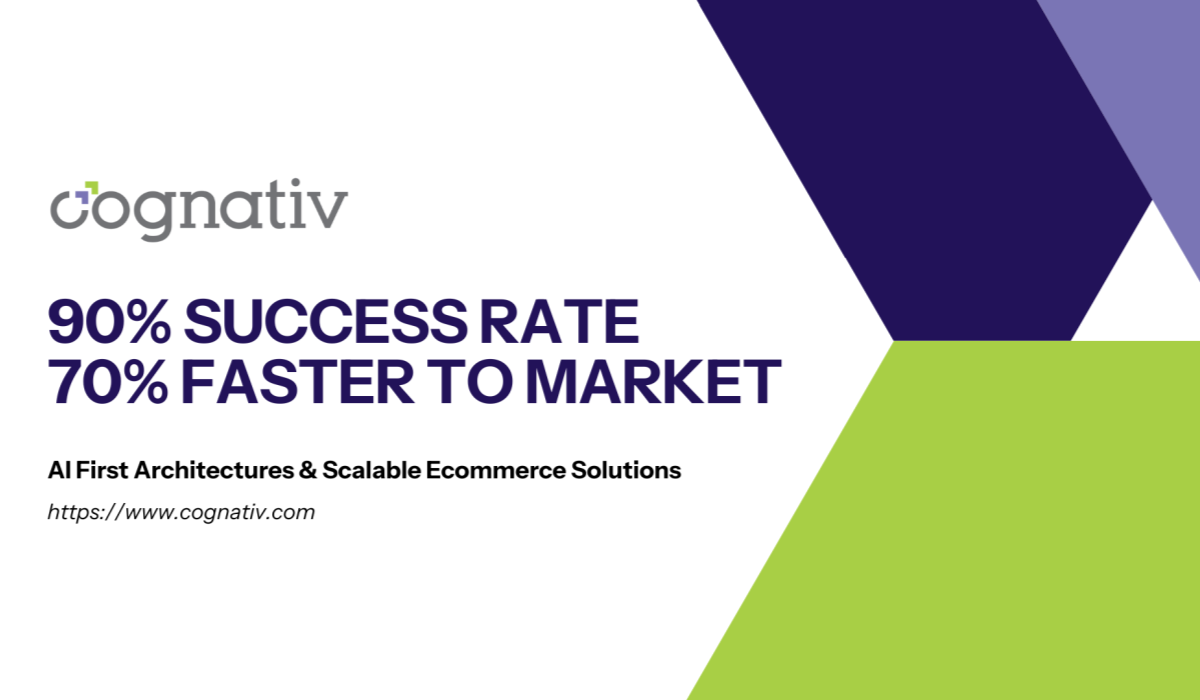LLM Services: Enhance Your Business with Advanced Language Models
Large Language Models (LLMs) are powerful AI tools designed to understand, process, and generate human-like language. A language model is an AI system trained to predict and produce text based on input data, and LLM stands for 'large language model', which refers to models with billions of parameters. LLMs are specifically designed to generate human like text as one of their core capabilities. Businesses are rapidly adopting these advanced technologies to boost productivity, enhance customer interactions, and derive valuable insights from unstructured data.
Whether it’s content creation, customer support, or data analysis, LLM services enable intelligent automation and communication at scale. LLMs are trained on large datasets, which enables them to understand context and generate human-like text across a wide range of applications.
Key Takeaways
-
LLM services typically involve the development, fine-tuning, and integration of pre-trained models to meet specific business needs. These pre-trained models are often referred to as base models, which can be further fine-tuned for specific tasks or industries.
-
These services extend across multiple platforms, including cloud providers like Google Cloud, and use techniques such as retrieval augmented generation and natural language processing to deliver relevant, context-aware outputs. Hugging Face is a leading provider of LLM services and models, offering an open-source community and accessible AI solutions.
-
When fine-tuned on high-quality, domain-specific data, these models generate more accurate, human-like responses tailored to industry-specific challenges, and organizations can fine tune base models to optimize performance for their unique requirements.
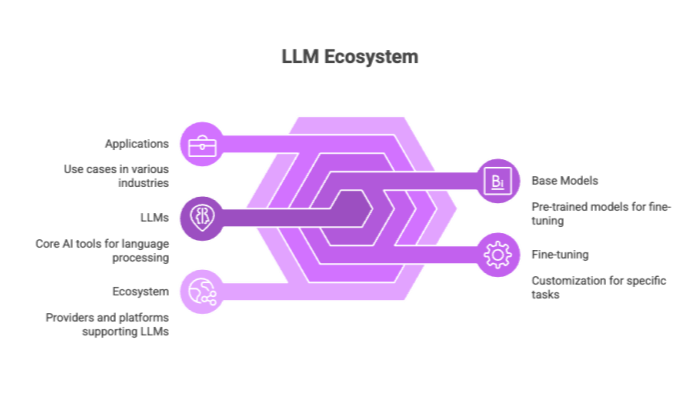

Introduction to LLM Services
Large language models (LLMs) represent a breakthrough in AI technology, enabling machines to understand and generate human language with remarkable accuracy.
Trained on vast amounts of text data, these models excel at complex tasks such as text generation, summarization, and question answering. By leveraging LLM services, businesses can automate routine processes, generate engaging content, and deliver personalized recommendations that enhance customer experiences.
The ability to process and interpret human language at scale gives companies a competitive edge, allowing them to drive innovation and respond quickly to changing market demands. Whether it’s creating compelling marketing copy, answering customer queries, or analyzing lengthy documents, LLMs open up new possibilities for operational efficiency and business growth.
LLM Development and Integration
The LLM development process begins with the training of large-scale models on vast corpora of text data. These models, once trained, gain a deep understanding of natural language patterns, grammar, and semantics. Through fine-tuning, models can be further adapted for specific tasks, allowing them to maximize relevance and accuracy in targeted applications. Seamless integration with existing systems ensures that LLM services deliver reliable results. These services are also designed for high performance in enterprise environments.
Key Elements of Development:
-
Fine-tuning: Customizing pre-trained models for specific business tasks using domain-relevant data.
-
Prompt engineering: Designing input prompts that optimize model output for accuracy and relevance.
-
Machine learning integration: Enhancing LLMs with broader AI capabilities for analytics, personalization, and automation.
Data scientists are integral to the development phase. They oversee model architecture, monitor model performance, and apply optimization techniques to improve accuracy.
Seamless integration into existing systems (like CRM platforms, APIs, and cloud-native applications) allows businesses to deploy LLMs without disrupting operations.
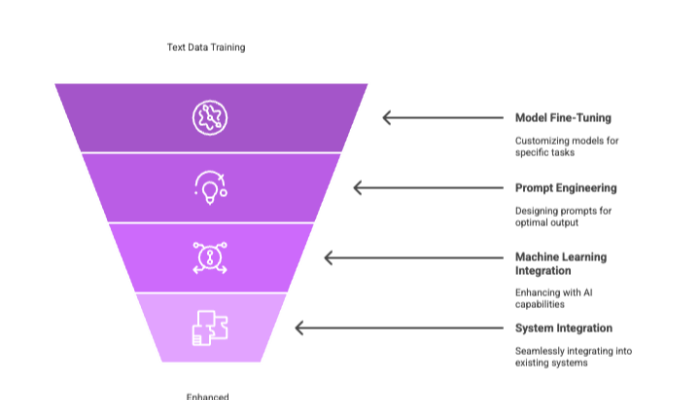

LLM Customization and Optimization
To fully realize the benefits of large language models, businesses must focus on customization and optimization. Fine-tuning pre-trained models with high-quality data tailored to specific business needs ensures that LLMs deliver superior model performance and relevant results. This process involves adjusting the model’s parameters so it better understands the context and nuances unique to a particular industry or application.
Prompt engineering further enhances effectiveness by crafting precise prompts that guide the base model’s responses without altering its core structure. Through these optimization techniques, companies can boost their language capabilities, streamline operations, and unlock new possibilities for innovation.
By aligning LLMs with their unique requirements, organizations achieve higher performance and operational efficiency, positioning themselves for sustained success.
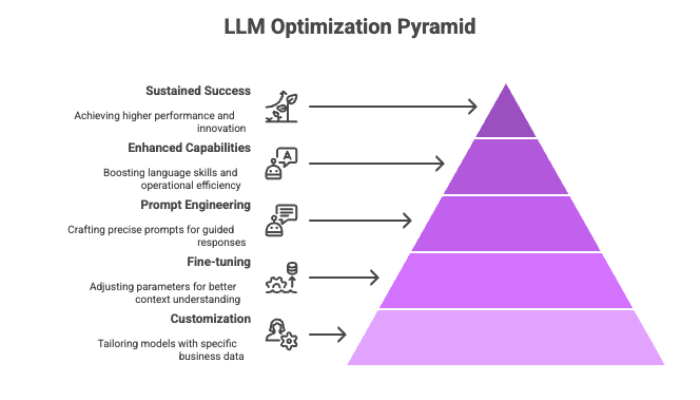

LLM Applications and Use Cases
The versatility of LLMs unlocks a range of applications across industries. LLM services enable a wide range of AI applications, allowing organizations to leverage advanced models for innovative solutions.
Common use cases include content generation, document summarization, code completion, and customer support automation. AI powered applications such as enterprise search tools and chatbots are also increasingly popular.
LLM powered applications can transform business operations and improve productivity by automating complex tasks and enhancing decision-making.
For example, in healthcare, LLMs can assist with medical documentation and patient communication. In finance, they streamline compliance and reporting. LLM solutions are being integrated into existing business systems for seamless automation and improved workflow efficiency. When considering LLM adoption, it is important to evaluate the ROI based on the specific application within a business process, as different use cases can yield varying benefits. LLMs are highly adaptable and can be tailored for various specific applications, such as translation, summarization, and more.
These broad LLM capabilities support diverse business needs, and their strength in understanding context enables more accurate and meaningful outputs.
Popular LLM Use Cases:
-
Text generation for blog posts, reports, and product descriptions.
-
Question answering systems for internal knowledge bases and customer service.
-
Virtual assistants that provide real-time, personalized recommendations.
-
Code generation to accelerate software development.
-
Data analysis and summarization of complex documents.
In healthcare, LLMs can summarize patient records. In finance, they analyze market reports. Tailored models improve performance in specific domains, reducing operational bottlenecks and enhancing accuracy.
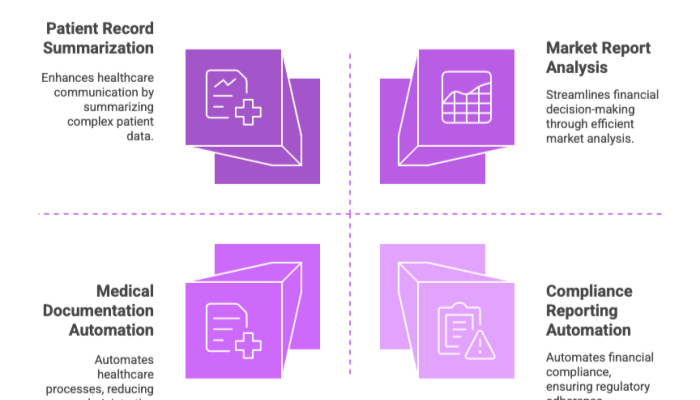

LLM Analysis and Insights
Harnessing the analytical power of large language models allows businesses to extract valuable insights from vast amounts of data. LLMs enable data scientists to perform advanced data analysis, uncovering hidden patterns and trends that inform strategic decision-making. By generating human-like text, these models can create engaging content and deliver personalized recommendations that resonate with customers. The ability to process and interpret complex information not only enhances customer experiences but also drives innovation across industries. With LLMs, organizations can stay ahead of the competition by leveraging data-driven insights to refine their strategies, optimize operations, and deliver tailored solutions that meet evolving business needs.
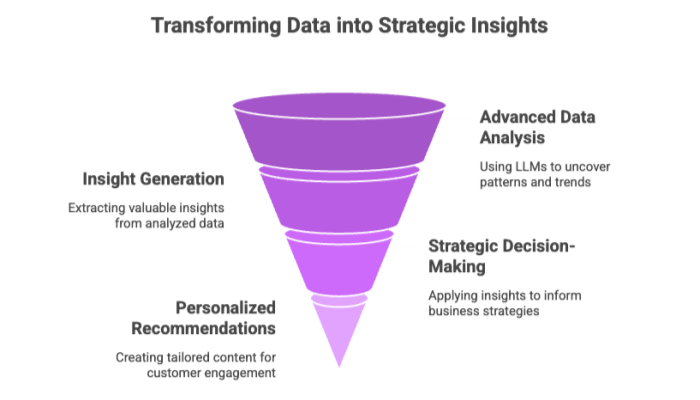

AI Capabilities and Generative AI
LLMs form the core of generative AI—a transformative approach to creating content and making sense of unstructured data. Large language models trained on extensive and diverse datasets enable these systems to perform a wide range of language tasks, such as text generation, translation, and summarization, without being limited to a single application.
Performance monitoring and continuous feedback are essential to ensure the reliability and accuracy of generative AI outputs. Evaluating LLM outputs using industry standards and established benchmarks, such as GLUE, SuperGLUE, SQuAD, and StrategyQA, helps maintain quality assurance and alignment with best practices.
Generative AI Capabilities:
-
Text creation for emails, campaigns, and chat interactions.
-
Image and video synthesis (when combined with multimodal models).
-
Zero-shot and few-shot learning, allowing LLMs to perform new tasks with little or no retraining.
Continuous performance monitoring and real-time feedback loops are crucial to ensure LLMs maintain optimal quality. Organizations can deploy automated systems to evaluate outputs and retrain the model when performance dips.


Business Processes and Improved Accuracy
LLMs are revolutionizing business processes by automating tasks and minimizing human error. They are capable of significantly reducing manual effort and processing time, while automating specific tasks within business processes.
Benefits:
-
Automated data entry, invoice processing, and summarization.
-
LLM-powered analytics offering instant insights and decision-making support.
-
Reduced labor costs and faster execution of repetitive workflows.
Industry benchmarks are essential to compare LLM performance, and ensure the models are aligned with business goals. LLMs excel when provided with rich contextual information, allowing them to deliver more relevant, high-accuracy responses.
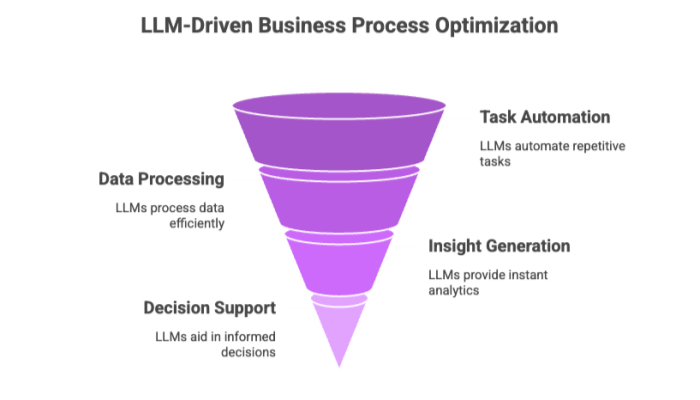

LLM Security and Deployment
As businesses adopt LLMs, enterprise-grade security becomes paramount.
Security Best Practices:
-
Use pre-trained and fine-tuned models only after thorough testing.
-
Implement role-based access controls, encryption, and audit logs.
-
Monitor for prompt injection attacks, data leakage, and misuse.
Deployment can be cloud-based, on-premise, or hybrid, depending on regulatory requirements. Businesses using Google Cloud or AWS benefit from integrated security frameworks and compliance support.
Mitigating risks and building trust in AI systems requires attention to AI safety, explainability, and governance protocols.
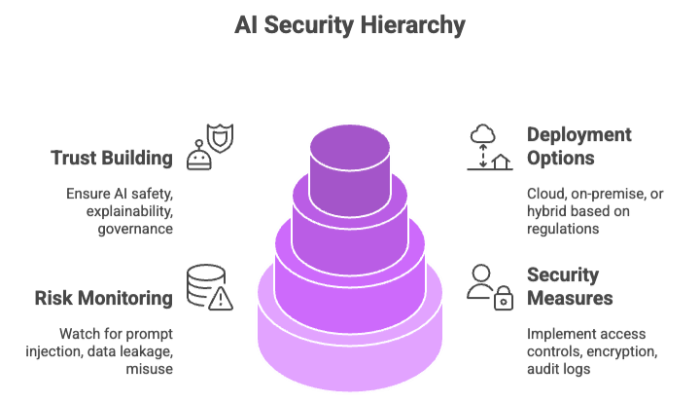

LLM Education and Training
As the adoption of large language models accelerates, comprehensive education and training become essential for successful integration. Businesses must equip their teams with the knowledge to navigate the evolving landscape of AI technology, including key features such as model size, natural language processing, and zero-shot learning. Understanding the principles of LLM development and the importance of continuous monitoring ensures seamless integration with existing systems and helps mitigate risks. Ongoing training empowers employees to maximize model performance, adapt to new advancements, and drive innovation throughout the AI journey. By investing in LLM education, organizations can unlock the full potential of these powerful models and maintain a competitive advantage in a rapidly changing digital world.


Conclusion and Future Developments
LLMs are shaping the future of AI in business by offering scalable, intelligent tools for language tasks. From streamlining internal operations to delivering personalized customer experiences, their impact is tangible and growing.
Choosing the right LLM solution, matched with the correct development strategy, gives companies a competitive edge in today’s digital economy.
As technology advances, we’ll see new capabilities, including multimodal models, domain-specific training, and edge-deployed LLMs for real-time use. Companies must stay agile and continue to evolve their AI strategies to remain ahead.

